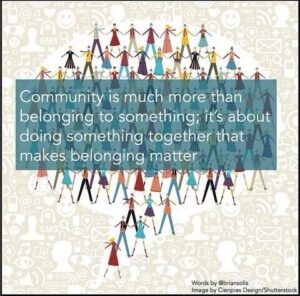
Influence is a controversial topic and its measurement and definition are increasingly scrutinized as social media democratizes one’s ability to earn stature and prominence in new online societies. There’s a clear delineation between influence and popularity and it’s important to understand that in social networks, influence is not derived by the quantity of followers, friends, clicks, or “likes.” Nor is it discernible by the frequency of which one participates in their respective communities. While these serve as indicators of influence, they are not necessarily constant factors in its quantification.
Merriam-Webster defines influence as the act or power of producing an effect without apparent exertion of force or direct exercise of command.
Exploring alternative sources, influence is described as the capacity to have an effect on the character, development, or behavior of someone or something, or the effect itself.
Influence vs. Influencer
In social networks, influence is naturally tied to individuals, where the extent, level, and effect of leverage or authority coalesces and contributes to a stature of varying degrees. Eventually, individuals who possess a propensity to cause a discernible effect earn a designation of influencer. When the funnel focuses on subject matter and themes, influencers are then further divided and ranked accordingly. Whether we agree or disagree on the idea of establishing a digital hierarchy, many social services are already verticalizing the horizontal nature of peer-to-peer networks. Klout, Edelmen’s TweetLevel, and PeerIndex, for instance, introduce a level of prominence into online connections measured by complex human algorithms.
Over the years, I’ve explored the roles of influencers in social networks and as a result, I’ve refined the definition as simply the ability to cause measurable actions and outcomes. Intentional influence then assumes that certain actions are therefore definable and as a result, desired activity and results are now designed into strategies. The execution of these plans is then dependent on the reach and conviction of the influential voices to which they’re aligned.
The Gender Divide in Social Networks
Late last year, I analyzed the demographic composition of many social networks and among other findings, it was clear that women represented the greatest majority of users. Dave McCandless visualized discovery in this wonderful infographic…

In April of this year, Nielsen released data that reinforced the role women play in social networking. As in social networking on the Web, women also ruled social networking in the mobile landscape.

Women on the Web: How Women are Shaping the Internet
10 years ago comScore reported that the number of women on the Web in the U.S. had surpassed the number of men. In 2010 comScore still finds that women are the digital mainstream and social networking is central to their online experience. In celebration of the 2010 Blogher Conference, comScore released a new report, “Social Networking Sites Reach a Higher Percentage of Women than Men Worldwide.”
If e-commerce is a form of influence, women dominate. In fact, the report shows that women shop more online and in aggregate, they drive a disproportionate amount of online spending, representing 58% of all online spending. Accordingly, women also spend more time in social networks than men at an average of 5.5 hours per month compared to 3.9.

According to the comScore report, women spent an average of 16.3% of their online time on social networks. In comparison, men dedicated roughly 11.7%.

The trend of women powering “the conversation” in social networks is indeed global across the board.

The Gender Divide: Influence on Twitter
The theme of women dominating popular social networks was recently validated by comScore’s research. In addition to other leading social networks, the study found that women represent the majority of Twitter’s population. And since Twitter is, for the time being, one of the only social networks where the data to measure social stature and influence is readily accessible, I partnered with Klout and PeopleBrowsr to analyze the balance of influence by gender.

As social networking continues to transform how both men and women communicate and connect, individuals gain varying levels of prominence with every interaction. Working with Klout and PeopleBrowsr, we analyzed the top 50,000 most influential people on Twitter to capture a snapshot of influence. The results practically matched the global Internet population as measured by comScore.
Twitter Influence Composition:
Males = 52%
Females = 48%
Global Internet Population, 18 + (Comscore)
Male = 54.3%
Females = 45.7%


Of these top tier influencers, females earned a spot above the median with an average score of 54 out of 100.

The average Klout score for males was two points higher at 56.
We then sampled 100,000 random Twitter users to measure the average level of influence for the general Twitter population. Upon sorting by gender, we discovered that the majority of the group was comprised by women, 54% vs. 46%. Of the random sample, the average Klout Scores weighed in favor of women, 34 compared to 31 for men.

While women represent a greater portion of the overall Twitter population, men edged slightly ahead in terms of Twitter’s top influencers. Yet that power balance shifts when looking at influence across the entire Twitterverse as women hold a higher level of influence within the general Twitter population.
As Twitter is young, the balance of influence is evolutionary. With the introduction of its new “human algorithm,” Twitter is encouraging its denizens to expand their social networks based on context over contacts. Over time, these new connections will affect how we as individuals contribute to our level of influence and ultimately the stature we merit within our relative social graphs and communities of interest (aka nicheworks.) Influence is something that’s both earned and cultivated and is yours to shape.
About Klout Scores
The overall Klout score ranges from 0 to 100. Klout’s algorithm involves three stages of semantic calculation. The first, described as “True Reach,” measures influence between each and every relationship, evaluating the engaged audience versus total audience. The secondary metric known as “Amplification Probability,” documents the likelihood of a specific tweet spreading beyond the primary network through retweets as well as generating a response from the immediate audience. Finally, Klout factors the “Network Value,” which measures the influence of those individuals who follow the original user and their propensity for sharing their content, which contributes to overall authority.
Connect with Brian Solis on Twitter, LinkedIn, Tumblr, Facebook
___
Please consider reading, Engage!: It will help you find answers to your questions…

___
Image Credit: ShutterStock






I'd urge people to be cautious about using media matrix (or any other partial data source) for broad decision making. Customize. Think about your customer. Repeat.
Indeed sir…
This is good to know especially when creating a social media strategy plan. It's important to know your audience and where they are.
thanks for the great statistics – this is very helpful info.
Great stats – interesting to observe the Ladies of Latin America taking the lead in social networking in time spent but not just in the realm of gender but in observance of time spent as that captive audience also out rank others in total. ..
This inspired me to post my thoughts on Klout and I'd like to know your take on it…
I appreciate all your insight and links to see the other sources @tweetlevel and @peerindex –
Nicole,
I read through your post and found it quite observational and informative. I agree with you that Klout does have some work to do. However, I think that persons using Klout really need to be mindful that numbers are not gospel. Though Klout may be a good tool for suggesting numerical data related to person's USAGE it is far from accurately suggesting a person's merits in terms of influence. You can have a Klout rate of 99 but it does not mean you are a useful influencer.
Lists are good for groceries and to-dos and birthdays. Influence can be quantified and measured in so many different ways that I'm not sure how we ever get to deciding who is and who isn't. One thing I know for sure, however, is that spelling words that begin with a C with a K instead is REALLY annoying (I'm looking at you, Klout!)
Meg, loved the komment, whoops, I meant…comment 😉
I find the data all very interesting. There is a gender divide of influence. I think women's influence perhaps is more quiet than men's. It isn't so outward. And women are less likely to admit to having influence. Or maybe most women don't realize their influence.
I think it seems that way because women's usage of social media is more cumsumption…so gossip, fashion, news, cooking tips etc…all consumption…whereas me tend to share and publish a lot more…posting of videoes and music, promotion of parties and events etc… so while women have larger numbers men are more likely to have more “true reach” and meaningful networking capacity.
It's YOUR network, so it reflects you more than it does the general demographic. In my network of 2,000+ most women tweet about law, business and politics and as many men as women talk about food and family. Few people of either gender in my network talk about fashion, though men DO talk more about music and women more about poetry (real contemporary poetry, not Hallmark cards). EVERYONE talks about books, marketing, social networking, children, community, social science, hard science and philosophy. If you don't like gossip, fashion, cooking tips and the like, you should go to mashable and find some women who are more compatible with your interests.
Thanks for this Brian. As a lawyer-mediator (a facilitator of negotiated resolutions to law suits) I talk A LOT about the difference between influence, which permits people to choose, and power, which forces people to choose someone else's choice for them. When speaking on negotiation to mixed gender groups, the question, “if you think of the most influential person in your life, which gender is that person?” ALWAYS elicits the answer “a woman” 90-100% of the time. Men are often surprised women list women; they are not at all surprised at their own answer. Women, of course, at not surprised at theirs. Women, being the emotional infrastructure of society, are natural and powerful influencers. When we claim this power, all those pesky wage and income gaps, glass ceilings and other impedimentia to women realizing their dreams will vanish. Thanks for giving us more data proving it!
Brian, Really great article. It's funny you wrote on gender differences, I spotted this on the same topic regarding women and sales http://teneotalent.com/teneotalent-blog/ . Women have always been great communicators, maybe the Internet will start leveling the field for us in terms of business influence and leadership.